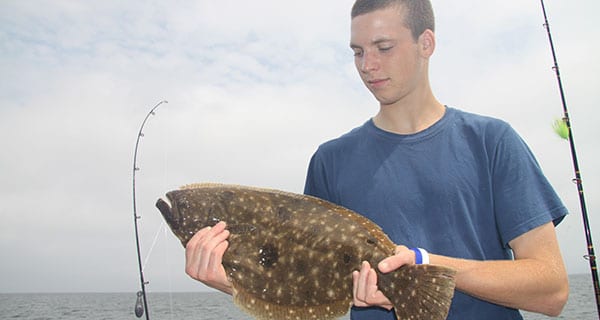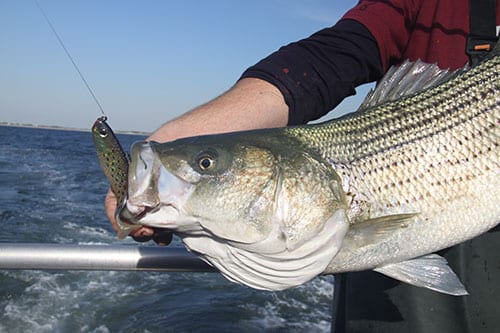
By Tom Schlichter
Being that the vast majority of Northeast striped bass tend to migrate up the coast from Chesapeake Bay or the Hudson River, it makes sense to meet them at the nearest point when the season firsts gets started. For most Coastal Angler readers living on Long Island or in Connecticut and Rhode Island, that means heading south and west. To that end, Freeport, NY, serves as a great jumping off point since it is here the linesiders begin smashing into bunker schools, entering the Long Island’s South Shore estuary system before fanning out along the beaches and continuing east toward Montauk Point or points further north and east.
If you already have a boat in the Jones Beach area at this time of year you are sitting pretty. By early May, the linesiders should already be cruising through near-shore ocean waters in pursuit of bunker and up inside Jones Inlet, Reynolds Channel and the various creeks, cuts and smaller bays that make up South Oyster Bay where they’ll gobble anything from spearing to sand crabs. There is some beach access throughout this area for those without boats, especially along the Jones Beach stretches, but if you aren’t lucky enough to be in the water in this sector you’ll otherwise have to depend on the charter boat fleet to reach the action.
That is, of course, unless you also happen to be a Freedom Boat Club member. The company provides its members a fleet of over 100 boats (in the 22 to 24 foot range) at eleven locations across Long Island, Connecticut and Rhode Island – and one of them just happens to be right on Freeport Creek, just east of the famous Nautical Mile on Woodcleft Canal. Members of any Freedom Boat Club across the country can sail out of any of the club’s 160+ franchise locations. That means if you are member of the Long Island club in Freeport, Babylon, Northport, Port Jefferson or Port Washington on Long Island, Mystic, CT, or even Newport, Rhode Island, you have access to the striper run, fluke, sea bass or whatever else happen to be swimming in the waters around Jones Inlet throughout the year.
“I used to have my own boat,” says Joe DeGregorio, a Freeport Freedom Boat Club member, “I like this better. I show up at the dock and the boat is ready to go. I hop in and head out and I don’t even have to scrub it down when I get back – that’s all taken care of by the staff.”
Bosh Firoz, another Freeport Boat Club member, agrees that the no-hassle approach to boating is the way to go. “I’m on the water headed to the fishing ground 10 minutes after I park my car,” he says with delight. He also points out there are an amazing number of great fishing spots within a half-hour ride of home base.

“I’m a serious striper fanatic,” says Firoz, “and I love that it’s a 15-minute straight shot from the dock to Jones Inlet. That means I can be out in the ocean and on the fish in less than half-an hour. The striper fishing around here has been super the past few years with May and October being the top months. I really love the spring season because there are tons of 20- to 30-pound stripers along with some even bigger fish riding herd on bunker schools. It makes for some very exciting action.”
For anglers with May stripers on the brain, Firoz suggests heading straight for the ocean. “I stick with the center consoles,” he states. “All are in good condition and have 150- to 200-hp outboards. They are efficient on gas with enough power to get out of Jones Inlet without any worries as long as Mother Nature cooperates.”
Once Firoz breaks the inlet, he begins searching east and west for flocks of diving birds. Often he’ll find them within a few hundred yards of the beach, although they can be as far as two or three miles from the surf some days. When he spots a working flock, he approaches the mayhem at slow speed, circling ahead of the fish so that the schools come to the boat rather than the other way around. A slow and quiet approach, he offers, rarely spooks the fish. Crashing the action at full throttle, on the other hand, can put both bass and bait down in a hurry.
“If there are bunker around, I’ll try to isolate a pod, snag a one and then swim it back into the school,” relates Firoz. “Most days, it doesn’t take long to hook-up. If the action is exploding on the surface, I might also use a popper – there’s nothing more exciting than seeing a big bass explode on your lure as it works across the surface. If we don’t spot any surface action after a little while we’ll try jigging or maybe even troll a bit to cover some ground as we keep searching. The Point Lookout area is generally where we find the bass first.”
While Firoz favors the bass whenever they are around, he’s not opposed to doing a little bottom fishing. Fluke are another of his favorite targets, as are black sea bass and porgies when in season. The fluke, he notes, have proved picky over the past couple of years with the best catches found around ocean structure. Fortunately, there are some great reefs within a short ride of the inlet.
“It’s only minutes to the Atlantic Beach Reef,” explains Firoz,” and both the McAllister Grounds and Hempstead Reef are a short ride away. All three hold some nice fluke, plus sea bass and porgies at different points in the year. Later, in the fall, they are also good for blackfishing. Bluefish action can also be real good here, both in the ocean and back inside the bays. The inside fish tend to be cocktails – perfect for the grill.”
Whereas Firoz tends to hit the ocean, DeGregorio does most of his Freeport fishing inside the bays. He’ll target stripers at nearby bridges such as those crossing the Meadowbrook, Loop and Wantagh parkways. Here anglers can connect on bucktails, swim shads, clam chum, bunker chunks or live bunker if the schools invade the inside passages. Marsh edges and channel mouths or bends are also good starting points. He’ll toss a variety of soft plastics and poppers for the bass, and also targets fluke during May and June. I’ve done particularly well in this area myself, most recently while tossing 1-ounce Panther Martin Big Fin soft plastic paddle tails (www.panthermartin.com/Lures/swimbaits/BigFin-Paddle-Tail) in white or chartreuse.
Just look at a map of the inside waters around Freeport and you’ll see tons of marsh islands, channels that range from deep to shallow, and structure points that just scream fish here. For DeGregorio, every spot holds some potential, and you’d be surprised how far back into the bays the fish can set up.
“The bridges are obvious flash points for the stripers,” says DeGregorio, who this year is a regular member but last season also ran the dock for Freedom Boat Club in Freeport. “Reynolds Channel is well-known for its fluking potential, too, but the back bays can really produce during May as well because the shallows heat up quicker than waters that are closer to the inlet.”
Indeed, local anglers have long worked Sloop Channel, Haunts Creek, Broad Creek Channel and Jones Bay, but DeGregorio points to The Narrows just west of Freeport Creek, Merrick Bay and Middle Bay as additional potential hot spots during May. The best thing about these spots, he says, is that they are all just minutes from the dock – and available to fish even when a roiled inlet prevents boaters from reaching the ocean.
It just further proof that for Freedom Boat Club members, membership has its privileges.









